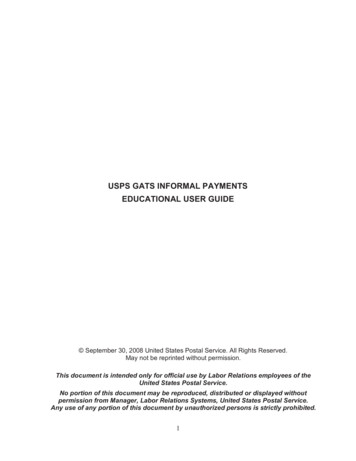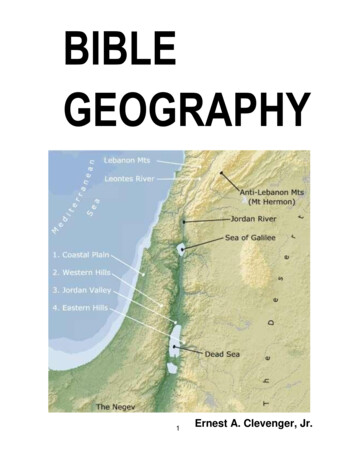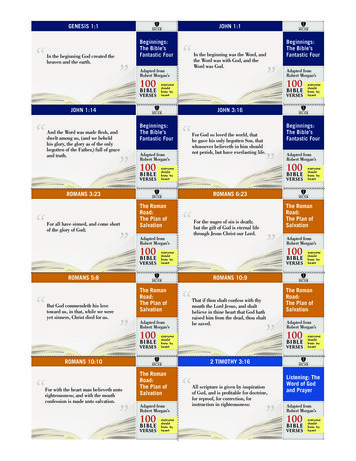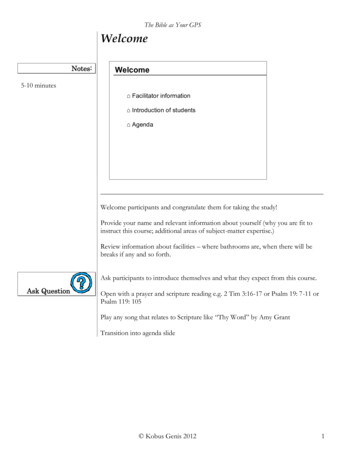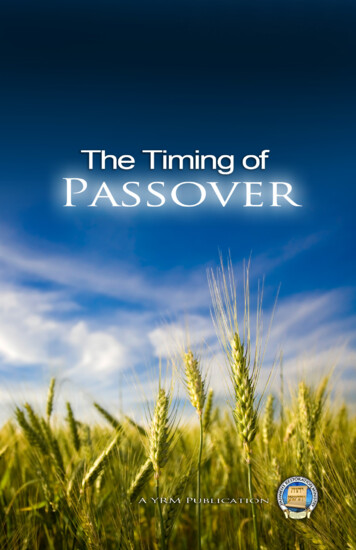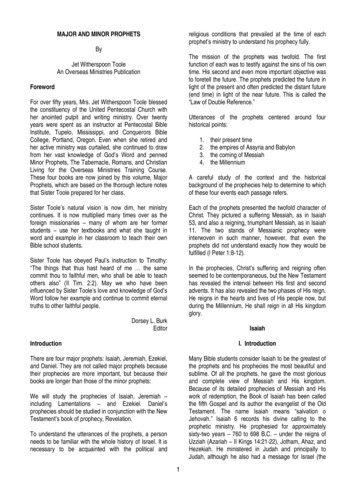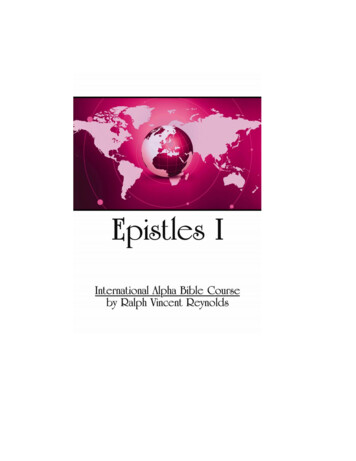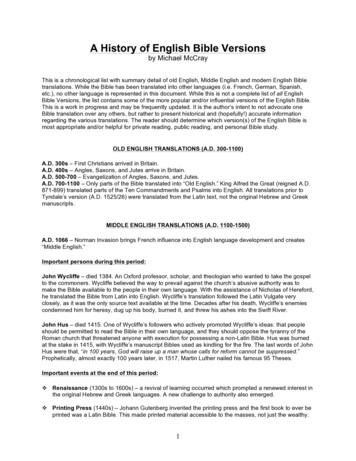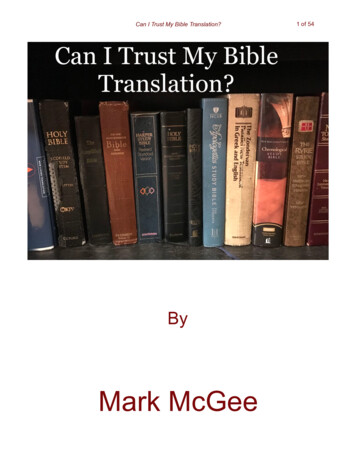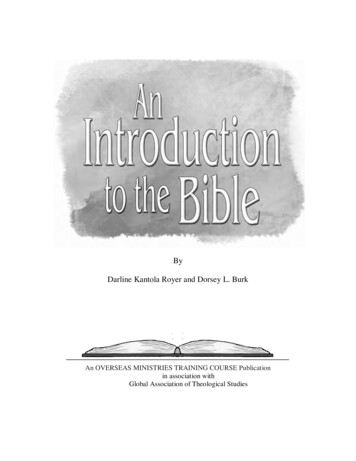
Transcription
An Introduction to the Bible 1ByDarline Kantola Royer and Dorsey L. BurkAn OVERSEAS MINISTRIES TRAINING COURSE Publicationin association withGlobal Association of Theological Studies
An Introduction to the Bible 2GATS Edition 2011 United Pentecostal Church InternationalLibrary of Congress Cataloging-in-Publication DataRoyer, Darline Kantola, 1936An introduction to the Bible / by Darline Kantola Royer and Dorsey L. Burk.p. cm."An Overseas Ministries training course publication in association with Global Associationof Theological Studies."ISBN 978-0-7577-4215-61. Bible--Introductions. 2. Bible--Textbooks. I. Burk, Dorsey, 1949- II. Title.BS475.3.R69 2011220.6'1--dc232011035263
An Introduction to the Bible 3Sponsored by:Truth TabernacleMarysville, California John Thomas, PastorIN MEMORY OFPASTOR-MISSIONARY ARLON R. ROYERSeptember 12, 1937 – April 25, 2009The Birth and Fruit of a Pastor’s Vision for MissionsIn 1979, Arlon Royer accepted the call to serve as pastor of the church in Marysville, California. Earlier in his ministry, he evangelized and then founded the United Pentecostal Church in Woodland, California. Prior to his move to Marysville, he served aspastor in Milpitas, California, where he nurtured many young people in the Lord following their conversion from the hippie world.After his move to Marysville, the church experienced steady growth. However,the small building in an undesirable area of the city withlimited parking hindered sustainable growth. Feelingtroubled over the seemingly hopeless situation withoutfinancial resources to relocate, Pastor Royer felt a senseof desperation. Then one day as he lingered in prayer, imploring God for an answer, these words came to him,“You can give your way out of this situation.” He understood, as he meditated on these words, that the giving mustbe beyond his local church. Thus, he called for a representative to come to his church and present Faith Promisemissions giving. From that time onward, Pastor Royer andTruth Tabernacle focused on generous giving to missions.Through the years, Truth Tabernacle has steadily increased its support of missions through Partners in Missions. At the time of this writing (September 2010), thechurch faithfully supports fifty-nine Partners in Missions.How did giving provide a way out of the desperate situation? As Truth Tabernacle’s giving to missions increased, the church finances improved. Then the day camewhen the church had finances to purchase a better piece of property with a larger building. In addition, the old church building sold for more than anticipated. Two years after
An Introduction to the Bible 4the church acquired new property, the Lord launched Pastor Royer into his personal mission’s assignment. However, the mission’s vision of Truth Tabernacle never waned undernew leadership. Pastor Royer had planted his vision for missions in the mind of his successor, and Truth Tabernacle has continued to see a steady increase in its congregationand finances. The church enlarged its newer auditorium once already, and another expansion is presently needed.During the years of his evangelistic and pastoral ministry, Pastor Royer twice offered himself for foreign missions service. When the door did not open, he accepted thatGod desired for him to remain in a pastoral role in support of missions. Indeed, thisproved to be God’s will for the first thirty years of his ministry. Then God took him on asurprising flight into foreign missions, following the death of his wife in December 1988.In March 1990, he flew to Kenya to visit Missionary Darline Kantola. He proposed toDarline with the intent of taking her back to California to become a pastor’s wife. In theweeks that followed, God spoke again to Pastor Royer about serving in missions. Beforethe time of their marriage in Kenya on June 2, 1990, Brother Royer submitted an application to FMD for appointment to Kenya. Thus in October 1990, Arlon and Darline Royerreceived a joint appointment to Kenya. After one term in Kenya, the Royers applied forappointment to Uganda, where they served two terms as the first UPCI resident missionary in Uganda before their retirement in 2008. The fruit of Brother Royer’s vision formissions can be witnessed in the United Apostolic Church of Uganda firmly planted andthriving in the nation of Uganda.Arlon Royer’s vision for reaching the lost did not cease with his promotion to hiseternal home in April 2009. During his years as pastor of Truth Tabernacle, he mentoredtwo Air Force men, John Thomas and John Floe, both of whom felt a call into ministryafter their New Birth experience. John Thomas received the Holy Ghost in his barrack’sroom in Fairbanks, Alaska, prior to his assignment to Beale Air Force Base in California.While stationed at Beale, he began attending and won his fellow airman, John Floe, to thePastor John Thomas and Assistant Pastor John Floestand before the Partners In Missions display atTruth Tabernacle, Marysville, California.
Pastor John Thomas and Assistant Pastor John Floestand before the Partners In Missions display atTruth Tabernacle in Marysville, California.An Introduction to the Bible 5Lord. In the course of time, John Thomas married Pastor Royer’s older daughter Esther.Two years later John Floe married Pastor Royer’s younger daughter Sharon. When PastorRoyer resigned the church after his appointment to Kenya, the church overwhelminglycalled for John Thomas to serve as pastor. While serving as pastor, he earned his B.A. inTheology through Christian Life College. When John Floe returned from a tour of duty inOkinawa, he became the assistant pastor under Pastor Thomas and continued studies,earning his Master’s Degree. Having attended church under Missionary Paul Dennis,John Floe came home with an enlarged mission’s vision. As pastor, John Thomas hasfostered the mission’s vision within his local church and district. He presently servesas the Western District Foreign Missions Secretary as well as booking services formissionaries. Thus, a vision for missions continues to expand through the ministries ofthe next generation of pastors. Pastor-Missionary Arlon Royer planted a vision andGod is giving the increase.
An Introduction to the Bible 6
An Introduction to the Bible 7FOREWORDFor several years Overseas Ministries has made available to overseas Bibleschools a textbook entitled Bible Survey written by Darline Kantola. Her outline of thevarious books of the Bible with comments offered on various units within the chapters ofthe Bible has been highly praised.Recently, we have felt the need to expand the Bible survey study series. Therefore, we are bringing to you three courses of study: An Introduction to the Bible, Surveyof the Old Testament, and Survey of the New Testament. My special thanks goes onceagain to Darline Kantola for her assistance in this, and we have added a new dimensionwith the capable and qualified contributions by Dorsey Burk and editing and typing byhis wife, Beverly.The commentaries in the Bible survey series are intended for Bible school teachers,Bible study group leaders, Bible school students, and other serious students of the Wordof God. I feel that this series will give solid help in understanding selected books of theOld and New Testaments. It is certainly not intended to be an exhaustive commentary.For each book there is helpful introduction discussing various subjects such as the authorship, date, purposes, and giving of explanations and views set forth throughout theyears. Each unit in the book is carefully examined and unfolded under the headings andsubheadings of a unifying outline. Challenges are faced courageously and the meaning ofeach is explained with the hope that lessons for our day can be extracted and applied. Thecourses are not meant to deal with a lot of details, but with the main facts of each bookand the content thereof.The Bible contains 3,566,480 letters, 810,697 words, 31,175 verses, 1,189chapters, and 66 books. It is, therefore, a “divine library,” and demands not only spiritualillumination but also the practical application of reverent and diligent study methods inorder to master its diversified subjects, as well as its unified message. I appreciate the authors of this series giving attention to the importance of the many aspects of the truths ofGod’s Word. I thank the authors for not trying to entertain us, but rather give us a map
An Introduction to the Bible 8with which to aid our study of the Word of God. It is my sincere thanks to the authors andit is my earnest prayer that their efforts will be prayerfully received. We certainly needmen and women who live the Bible. May the Lord use these exceedingly useful volumesto help us all learn, love, and live the Word of God.Robert K. Rodenbush, B.Th., MA.Foreign Missions Division/United Pentecostal Church International1983
An Introduction to the Bible 9CONTENTSI.Introduction to Bible Surveypage 11A. Bible survey provides a panoramic view of the BibleB. Bible survey reveals the treasures of the greatest book in existenceC. Bible survey gives a foundation for all studyII.The Importance of Bible StudyA. The Bible is God’s WordB. The Bible must be studied to be knownC. A suggested plan for Bible readingpage 13Ill.The Origin of the Names for the BibleA. History of the word BibleB. Other names used for the Biblepage 17IV.The Format of the BibleA. General information about the BibleB. The Old and New TestamentsC. The order of the books and the divisionspage 19The Inspiration of the BibleA. The significance of inspirationB. The meaning of inspirationC. The extent of inspirationD. The proof of inspirationpage 25VI.The Preparation of the BibleA. The birth of the BibleB. The original manuscriptsC. The existing manuscriptsD. The preparation of the manuscripts and manuscript copiesE. The formation of the canonF. The apocryphal books (not a part of the Bible)page 31VII.The Transmission of the BibleA. The text of the Old TestamentB. The text of the New Testamentpage 43Major Versions of the BibleA. Availability of God’s Wordpage 47V.VIII.
An Introduction to the Bible 10B.C.D.E.F.G.H.IX.X.Versions that preceded the English BibleThe early English versionsThe versions of Wycliffe and TyndaleOther sixteenth-century translationsThe Authorized Version or the King James VersionEnglish translations within the last 150 yearsModern translations in EnglishHow to Study the BibleA. How to prepare for Bible studyB. The spiritual preparation necessary for Bible studyC. The benefits of Bible studyD. Some rules for Bible studyE. How to study a book of the BibleF. How to study a chapter of the BibleG. How to study a Bible doctrineH. How to study a Bible biographyI. How to study a Bible miracleJ. How to study a Bible parableK. Summarypage 57Alleged Contradictions and Errors in the BibleA. Two Accounts of the Sermon on the MountB. Matthew 28:19 and Acts 2:38C. Paul’s Supposed MistakeD. Matthew’s Supposed MistakeE. David’s Numbering the PeopleF. Genealogies of Our LordG. Inscription on the CrossH. Jonah and the Whalepage 65Missionary Spotlightpage 71
An Introduction to the Bible 11I. INTRODUCTION TO BIBLESURVEYA.Bible Survey Provides a Panoramic View of the BibleThe typical Christian is often perplexed when he first begins to read the Bible.He usually begins somewhere in the New Testament and continues reading there morefrequently because the content of the Old Testament often seems confusing. He doesnot see the Bible as a unified whole; he sees it in “bits and pieces” with no meaningfulrelationship between the parts. This is not the picture that God intends for mankind tohave. He wants readers to see His whole plan for mankind as displayed and revealed inall of Scripture.Every portion of the Bible lends itself well to a detailed study. However, before astudy of the parts can attain their full significance, the student must be able to view thewhole purpose and content of Scripture. A Bible survey approach provides that overallknowledge of the Bible that is necessary for a correct understanding and interpretation ofthe individual portions of Scripture.A panoramic view of the Bible shows God’s redemptive purpose for the humanrace. Without understanding this purpose, a man could easily regard some portions of theBible as endless, detailed descriptions with little or no value. With this knowledge, theBible pages can come alive with meaning to any student.B.Bible Survey Reveals the Treasures of the Greatest Book inExistenceAs previously mentioned, the revelation of God’s Plan of Redemption for mankind is the main theme running through the pages of the Bible. A quick survey of thisBook of books gives the diligent student a clear concept of this plan. He sees the God ofCreation operating through the course of history to reveal Himself in flesh to become the
An Introduction to the Bible 12God of Redemption. The narratives of the Old Testament are not just fascinating tales tobe told, but they are revelations by God of His dealing with mankind that point towardthe climactic events of the New Testament. From Genesis to Revelation God revealsHimself, with meaningful picture added to meaningful picture, until the complete panorama of divine redemption stands unveiled. One who surveys the Bible with open eyesfinds his vision reaching into the distance to see and to know a great acquaintance withthe treasures of the Book of God.C.Bible Survey Gives a Foundation for All StudyWilliam Tyndale believed that “a ploughboy with the Bible would know more ofGod than the most learned ecclesiastic who ignored it.” We could add to this that a Spiritfilled believer who knows his Bible will be more effective in sharing God with othersthan a theological scholar who merely knows intellectual ideas about the Bible ratherthan knowing the direct and simple message of the Bible.While a quick survey of the Bible will not give sufficient time for a completereading of the Bible, a student must waste no time in setting up a consistent schedule thatwill take him completely through the Bible in direct contact with all the words of Scripture. This important factor cannot be overemphasized. Some of the greatest preachers ofPentecost had no study resources other than the Scriptures. No doubt, this is what madethem so great in their knowledge of God. They depended on the Word and the impressions of the Holy Ghost to give them knowledge and understanding. I trust that our day ofintellectual pursuit will never cause us to depend on commentaries and various books andauthors to the exclusion of the Word itself. May every Pentecostal student determine inhis heart with the psalmist: “Thy word is a lamp unto my feet, and a light unto my path”(Psalm 119:105). May he never depart from a careful attention to the words of his Bibleto become enslaved with a consuming fascination for books filled with mere ideas orinterpretations of men.The Christian should always keep the study of his Bible as the foundation of allhis studies. He should begin with his Bible and use it as an evaluation guide for any ideasor philosophies he encounters.
An Introduction to the Bible 13II. THE IMPORTANCE OF BIBLESTUDYA.The Bible Is God’s WordMany things bear witness to the authority of the Scriptures as the Word of God.Thus, the person who comes to know and understand the contents of the Bible will reapgreat blessings as he adjusts his life according to its precepts. The person who ignoresand despises the words of this Book will do himself untold harm. The Bible declares “allscripture is given by inspiration of God” (II Timothy 3:16) and that “holy men of Godspake as they were moved by the Holy Ghost” (II Peter 1:21). Through personal experience, many great men of the past and present have given testimony to the accuracy ofScripture in being what it claims to be. How could finite humanity dare to ignore theimportance of this message from God?C. W. Slemming, in his work, The Bible Digest, makes these declarations:Many scientists have verified the Word of God through investigations. Manyarchaeologists have proved the Word of God through discovery. Many saintshave enjoyed the Word of God through reading and obedience. Many infidels have attacked the Word of God without disproving it.God has miraculously preserved His Word for the benefit of mankind. One uniquetestimony of this is cited by Sidney Collett in All about the Bible:Voltaire, the noted French infidel who died in 1778, said that in one hundred years from his time Christianity would be swept from existence andpassed into history. But what has happened? Voltaire has passed into history; while the circulation of the Bible continues to increase in almost allparts of the world.
An Introduction to the Bible 14Other accounts state that Voltaire declared that within one hundred years only afew odd Bibles would be found in museums. At an auction sale Voltaire’s entire works(ninety-one volumes) were sold for the equivalent of 1.41, but the British governmentbought just a portion of the Bible (the Codex Siniaticus) for the equivalent of 700,000,the highest price ever paid for a book. Just fifty years after Voltaire’s death, the GenevaBible Society used his press and house to produce Bibles by the stacks.B.The Bible Must Be Studied to Be KnownNo substitute can be found for a careful and constant study of the Bible, for it isby the words of Scripture that we know God. God gave His Word to bring moral andspiritual guidance to mankind. The person who acknowledges this will give careful attention to learning and heeding its contents.Second Timothy 3:15-17 shows the importance of knowledge of the Word ofGod. Timothy was recognized as one who had knowledge of the “holy scriptures” fromhis childhood. Then he was instructed concerning the purpose of “scripture.” The instruction is for all mankind, not just Timothy:All scripture is given by inspiration of God, and is profitable for doctrine, for reproof, for correction, for instruction in righteousness: thatthe man of God may be perfect, thoroughly furnished unto all goodworks (II Timothy 3:16-17).It is a dangerous thing to study what men think about the Bible without givingforemost attention to what the Bible says for itself. The very words of the Bible will convict a person of sin and lead him into paths of righteousness. The writer of Hebrewsasserted that “the word of God is quick and powerful” (Hebrews 4:12).A reading of the Bible is a requisite for studying the Bible. The study of scores ofbooks about the Bible will never compensate for a firsthand reading of the direct wordsof Scripture. Christians need to be challenged to read the Word of the Lord. In a recentmeeting, I asked for a show of hands of those who had read through the Old and NewTestaments. In this group of approximately 150 Spirit-filled believers, only three had readthrough the Old Testament, and only around twenty had read the New Testament. Does thisnot testify to a lack of knowledge in the Scriptures? This should challenge the Bible teacherand student to create in others a thirst for a consistent reading and study of God’s Word.Some readers take portions of the Bible and use them to support their “pet” ideas.But God would have mankind to know the whole message of His Word. F. F. Bruce, inThe Books and the Parchments, states, “Any part of the human body can only be properlyexplained in reference to the whole body. And any part of the Bible can only be properlyexplained in reference to the whole Bible.”
An Introduction to the Bible 15C.A Suggested Plan for Bible ReadingBible reading is the foundation for Bible study. I trust this has been well stressedin the previous section. Since many students fail to get started in a systematic reading ofthe Bible, the following simple suggestions are made.First, obtain or make a chart that lists all the books of the Bible with numbers toindicate each chapter of each book. These chapters can then be marked one by one as thechapter is read.Example:Esther 1 2 3 4 5 6 7 8 9 10I have learned that even college students respond much better to a regular program ofBible reading when they can chart their progress.Second, plan a time especially for Bible reading. Our lives need to be adjusted sothat time is given to reading of the Word. It is not possible for the pulpit or classroomteaching to give us all the exposure to the Bible we need.Be encouraged by this knowledge: Campbell Morgan once stated, “The Bible canbe read from Genesis 1 to Revelation 22 at pulpit rate in seventy-eight hours.” As he waschallenged by a lawyer on his statement, Morgan challenged the jurist to try it. The lawyer did. He read the Bible through in less than eighty hours. In simple terms, this meansthat the average reader could read through the Bible in one year in less than fifteenminutes per day.
An Introduction to the Bible 16
An Introduction to the Bible 17III. THE ORIGIN OF THE NAMES FORTHE BIBLEA.History of the Word BibleThe Bible’s singular name reflects the unity or oneness of the content. Originallythe title was not singular, for in the early days of Christianity the Greek-speaking Christians referred to all the Old and New Testament books as Ta Biblia, meaning “the books.”The Latins borrowed the title Biblia but translated it in the singular. This word then camethrough Old French into English as Bible.The Greek use of the title, Ta Biblia, originated from the name of the papyrus orbyblos reed used in antiquity for making scrolls or books. The Greeks quite naturallycame to title a book biblios or a small book biblion. Later the Greeks called their sacredScriptures, Ta Biblia, “the books.”B.Other Names Used for the Bible1.ScripturesThe term Scriptures is derived from the Latin and means “the writings.” The useof Scripture to refer to the Bible developed from its use in Bible passages. The word hascome into common use as another name for the Bible.In its precise meaning, the singular word Scripture refers to passages in the OldTestament that are quoted or referred to in the New Testament. In the plural, Scripturesrefers to books or a collection of books of the Old Testament. As the writings of the NewTestament came into being, they too became known as Scripture or Scriptures.
An Introduction to the Bible 18The word Scripture is found thirty-two times in the King James Version. Theplural form is found twenty-one times. Daniel 10:21 is the only Old Testament passagethat employs the direct term Scripture.Examples of use in the Bible can be noted: 2.In Exodus 32:16 the commandments written on tablets of stone are called “thewriting of God.”Daniel 10:21 refers to “the scripture of truth.”Mark 12:10 refers to a particular “scripture” of the Old Testament (Psalm118:22).Romans 9:17 refers to the account of the children of Israel in Egypt as “scripture.”The words delivered to Abraham are regarded as “scripture” (Galatians 3:8).II Timothy 3:16 identifies “all scripture” as being “given by inspiration ofGod.”The Word of God“The Word of God” is a phrase that has come into common use to identify theBible. It is certainly a proper title, for it marks the Bible as being distinct from all otherwritings. This phrase is used repeatedly in the Bible in reference to the words God hasgiven unto mankind. A few examples are: “The word of God came to Nathan” (I Chronicles 17:3).The Psalms speak of the “word of the Lord” (Psalm 18:30; 33:4; 33:6;105:19).“Every word of God is pure” (Proverbs 30:5).“Man shall not live by bread alone, but by every word of God” (Luke 4:4).“For the word of God is quick, and powerful, and sharper than any twoedgedsword” (Hebrews 4:12).In a correct sense, we can refer to the total content of the Bible as “the Word ofGod,” for these words in their entirety make up the body of truth that God has divinelyimparted to the world. They are of a certainty God’s words to mankind!
An Introduction to the Bible 19IV. THE FORMAT OF THE BIBLEA.General Information about the Bible1.Authorship and Time of WritingThe Bible is comprised of sixty-six books written over a period of about 1,600years by about forty different writers. Moses authored the first books of the Bible around1500 BC by the inspiration of God, and the apostle John added God’s final revelationabout AD 97. God used men of every station of life to pen His words to mankind:herdsmen, kings, priests, prophets, farm laborers, fishermen, physicians, tax collectors,lawyers, and teachers. These “holy men of God spake as they were moved by the HolyGhost” (II Peter 1:21).2.Unity of the BibleWhile the Bible is a collection of sixty-six books, it is by no means just a smalllibrary of varied subjects. It is not a curious collector’s item. Its sixty-six books form aunified whole with a main theme running through each book and tying one to the other.These books are the “divine library” that fit together in perfect harmony. The content ofeach book adds something to the total revelation that God designed to give mankind.Though authored by many different men in different stages of history, no bookcontradicts another book. The writings of one book are more clearly understood by comparing them with the writings of another book. Even though Moses wrote at Sinai, separated from John the Revelator on the Isle of Patmos by 1600 years, we often compareGenesis with Revelation and find continuity of thought. The Old Testament propheciesare marvelously and accurately fulfilled in the New Testament. Agnostics who have triedto refute this unity have found themselves bowing in recognition as they have studiedopenly and carefully the evidences of this unity.
An Introduction to the Bible 203.Languages of the BibleThe original language of the Old Testament was Hebrew. Three small sectionswere, however, written in Aramaic: Jeremiah 10:11; Daniel 2:4-7:28; and Ezra 4:8-6:18.The original language of the New Testament was Greek. This was the common languageof the Roman world. Even though the Jews continued to speak Aramaic in the days ofChrist, God directed men to write the New Testament in the language that would be morefreely read and widely understood. While Aramaic was the common language in Palestine in the time of Christ, the writers of the New Testament would have been familiarwith the universal language, Greek.B.The Old and New Testaments1.Main Divisions of the BibleThe Bible is divided into two main sections, the Old and New Testaments.Thirty-nine books comprise the Old Testament and twenty-seven books make up theNew Testament.2.Meaning of TestamentThe word testament, as used for these Bible divisions, refers to the idea of “covenant”or “agreement.” The word testament comes from the Latin word testamentum, which means“a witness.” The Greek usage supplies the idea of a witness that constitutes an agreement.The contents of the Bible do certainly convey the terms of God’s covenant with man.What we now call the Old Testament was referred to in the early Christian era asthe “Scriptures” or “the Law and the Prophets.” When the New Testament was writtenand recognized, the title “Old Covenant” was applied to the early writings that we nowlabel the Old Testament. The name “New Covenant” was used to identify the writings ofthe apostles and their companion that we now call the New Testament. The designationof the Old and New Testaments as such has passed into the English from the Latin usage.C.The Order of the Books and the DivisionsThe present arrangement of the books of the Bible is in part chronological, largelyhistorical, and in part logical (arranged by type of material).The Hebrew Scriptures were arranged in three parts as follows: The Law of MosesThe ProphetsThe Psalms or other writings
An Introduction to the Bible 21Jesus referenced these divisions in Luke 24:44 and thus gave His approval to theentirety of the Old Testament Scriptures: “That all things must be fulfilled, which werewritten in the law of Moses, and in the prophets, and in the psalms, concerning me.” ThisHebrew arrangement still appears in most Hebrew manuscripts, but the English and otherversions follow the order and divisions of the Septuagint version (Greek translation of theHebrew Scriptures completed during the third century BC.) The Hebrew Old Testamentcontains twenty-four books while translations that follow the Septuagint version containthirty-nine books. The thirty-nine books of the Old Testament are commonly groupedinto five main sections: The Pentateuch (the five books of Moses)1.2.3.4.5. The Historical Books6.7.8.9.10.11.12.13.14.15.16.17. esRuthI SamuelII SamuelI KingsII KingsI ChroniclesII ChroniclesEzraNehemiahEstherThe Wisdom or Poetical ong of Solomon
An Introduction to the Bible 22 The Prophetical Booksa. The Major Prophets (5 kielDanielb. The Minor Prophets (12 ZechariahMalachiAs one can see, the Old Testament consists of five main sections. The first twodivisions (the Pentateuch and the historical books) cover the entire period of Old Testament events. Most of the books in the last three divisions were written in, or relate to, thelast part of the period covered by the historical books. For example, many of the Psalmsrelate to the period of the kings. Likewise, the prophets wrote chiefly during the reign ofkings and in the restoration period. The designation of the “major” and “minor” prophetshas nothing to do with the importance or quality of the messages. It merely designates thelonger books from the shorter ones.The twenty-seven books of the New Testament are commonly grouped as: The Gospels1.2.3.4.MatthewMarkLukeJohn
An Introduction to the Bible 23 History5. The Book of ActsThe Epi
A. Bible survey provides a panoramic view of the Bible B. Bible survey reveals the treasures of the greatest book in existence C. Bible survey gives a foundation for all study II. The Importance of Bible Study page 13 A. The Bible is God's Word B. The Bible must be studied to be known C. A suggested plan for Bible reading Ill.
